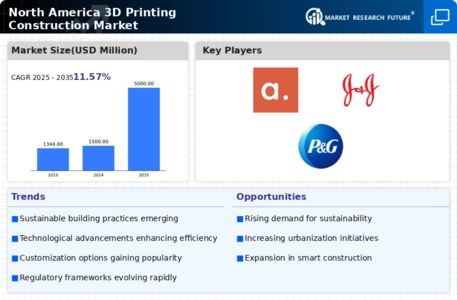Market Share
North America 3D Printing Construction Market Share Analysis
The landscape of the North American 3D Printing Construction market is continually changing as firms try to find their niche in order to capture a significant portion of the market. Innovation through differentiation has become one of the leading strategies employed by players within this sector. Many companies invest heavily in research and development to develop better quality parts for use in their three-dimensional printers specifically designed for construction purposes. Additionally, partnerships and collaborations play a pivotal role in market share positioning. Many firms are forging strategic alliances with other players, including technology providers and construction companies, to leverage complementary strengths and broaden their market reach. For instance, many collaborative agreements have been reached between these builders with different personalities regarding the adoption of this new approach. This will make it more difficult to beat in terms of comprehensive offering since it can now combine these resources completely; it will be able to offer customers everything from concept development through execution while also being competitive across all aspects associated with three-dimensional print building services. Another market share positioning strategy that companies in North America's 3D Printing Construction market adopt is cost leadership. Some firms are focused on reducing their overall costs through optimizing their production processes, economies of scale, and supply chain management. Moreover, the market is embracing customer-centric strategies where products and services are meant to serve the needs and preferences of their target customers better. In this case, the primary aim for these businesses is to provide tailored products that can satisfy their specific consumers more effectively than before. This approach implies understanding the peculiarities of different construction projects and delivering customized 3D printing solutions into such processes. The idea here is to produce what the customers need to establish strong brand relationships with clients, thereby securing a greater portion of the total sale. Besides employing these tactics, companies are also considering expanding geographically as another way through which they can grow their market share. North America offers a broad range of markets with diverse demands; hence, companies have strategically extended their reach in various parts of this region. Market share positioning strategies have now begun factoring in environmental sustainability issues. With increased emphasis on sustainable building practices, companies are integrating eco-friendly materials and techniques into their 3D printing construction technologies. Therefore, by aligning themselves with global sustainability goals while meeting an increasing demand for environmentally sensitive alternatives, businesses will be able to build good reputations that attract other nature-conscious customers who want them to lead such markets.


 Source: Secondary Research, Primary Research, Market Research Future Database and Analyst Review
Source: Secondary Research, Primary Research, Market Research Future Database and Analyst Review



Leave a Comment